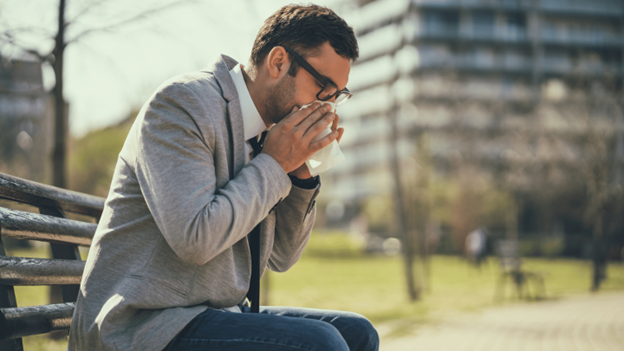
Is it allergy season? How to prepare for spring allergies.
The sun is shining, the flowers are blooming… and your nose won’t stop running. If sneezing, itchy eyes and congestion seem to strike as soon as the seasons change, you’re not alone. Seasonal allergies affect nearly 81 million Americans, including 1 in 4 adults and nearly 1 in 5 children.
But is allergy season officially here? And how can you tell if your symptoms are due to allergies—or just a lingering cold? Understanding when allergy season starts, what triggers your symptoms and how to prepare can make all the difference. Let’s break it down so you can breathe easier this spring.
When does allergy season start? Understanding spring allergy triggers.
For millions of people, spring allergies start before spring even arrives. While many assume allergy season begins when the weather warms up, pollen levels often spike in late winter. This means some allergy sufferers start experiencing symptoms as early as February or March, depending on where they live.
Peak months for spring allergies.
- February – April. Tree pollen is the biggest trigger during early spring. Trees like oak, birch, cedar and pine begin releasing pollen, often before flowers bloom.
- April – June. Grass pollen takes over in late spring, causing another round of allergy symptoms that can persist into early summer.
Year-round triggers. While dust mites, pet dander and mold can cause symptoms anytime, they often get worse in spring due to increased humidity and rainfall.
Is allergy season getting worse?
If you’re noticing allergy symptoms earlier in the year, you’re not imagining it—spring allergies are getting worse, making preparation more important than ever. But why is allergy season getting worse?
Allergy seasons are arriving earlier and lasting longer than ever before. A 2021 study found that pollen season has extended by nearly 20 days over the past 30 years, increasing exposure and worsening symptoms for seasonal allergy sufferers.
Warmer temperatures also allow trees and grasses to produce higher concentrations of pollen, making your seasonal allergy symptoms even worse.
Common symptoms of seasonal allergies and how to tell them apart from a cold.
Spring allergies and the common cold share many symptoms, but there are key differences.
Knowing what you're dealing with can help you take the right steps for relief.
| Symptom | Seasonal Allergies | Common Cold |
| Sneezing | Frequent, sudden | Less frequent, gradual onset |
| Runny nose | Thin, clear mucus | Thicker, yellow or green mucus |
| Itchy eyes | Very common | Rare |
| Coughing | Sometimes, mild | Common, often worse at night |
| Fever | No | Sometimes, mild |
| Body aches | No | Sometimes |
| Duration | Weeks or months | Usually 7-10 days |
Key takeaway: If your symptoms last longer than two weeks and include itchy, watery eyes, it’s probably allergies. Colds usually resolve within a week and come with fever or body aches, which allergies do not.
How to prepare for spring allergies: prevention and treatment tips.
Spring allergy symptoms can be frustrating, but the right prevention strategies and treatments can help keep them under control.
Preventative measures to reduce pollen exposure this allergy season.
- Check daily pollen counts. Websites like the National Allergy Bureau (AAA) and weather apps provide real-time pollen forecasts to help you plan outdoor activities.
- Keep windows closed. Peak pollen hours are between 5 AM and 10 AM, so keep windows shut and run an air purifier with a HEPA filter indoors.
- Shower after being outside. Pollen sticks to skin, hair and clothing. A quick rinse-off can prevent tracking allergens into your home.
- Change air filters regularly. Pollen and mold can build up in HVAC systems and car air filters, so replace them every 1-3 months during allergy season.
Treatment options for allergy relief
- Antihistamines. Over-the-counter options like loratadine (Claritin), cetirizine (Zyrtec), or fexofenadine (Allegra) can help reduce sneezing, itching and congestion.
- Nasal sprays. Fluticasone (Flonase) and mometasone (Nasonex) are steroid sprays that reduce inflammation in nasal passages and work best when used consistently.
- Eye drops. Antihistamine eye drops like ketotifen (Zaditor) can relieve itchy, watery eyes.
- Allergy shots (immunotherapy). For severe cases, allergists can provide long-term relief through allergy immunotherapy, which gradually desensitizes the body to allergens.
Don’t let allergies take over your spring—CityMD can help!
Spring allergies don’t have to ruin your day. If your symptoms are getting worse each year or aren’t responding to over-the-counter medications, CityMD is here to help. Our urgent care providers can assess your symptoms, offer prescription treatments and help you find relief—no appointment needed.
Walk into your nearest CityMD today and start breathing easier this allergy season!

We’re ready to care for you.
Visit any CityMD urgent care location in your community today for an evaluation with one of our expert providers.